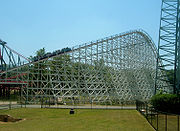.gif)
The Great American Scream Machine (Six Flags Over Georgia)
Encyclopedia
Great American Scream Machine is a wooden roller coaster
located at Six Flags Over Georgia
. The 105 feet (32 m)-tall ride reaches a top speed of 57 mi/h. GASM, as it is known to park workers, was built by the Philadelphia Toboggan Company
in 1973 with Marvin M. Black & Sons as the contractor. When it opened, it was the tallest wooden roller coaster in the world, and riders were given a "Red Badge of Courage" button for riding the coaster.
 A computerized block system is used to prevent trains from contacting each other. GASM has 5 blocks: Station, Transfer Table, Lift, Main Brake, and Ready Brake. Normal operation uses two trains; however, it can be operated with only one. During two-train operation, if the train in the station has not fully exited the loading platform, the inbound train will stop abruptly in the Main Brakes. A combination of proximity switches, mechanical switches, photoelectric sensors, and timers are all used by the controller to track train movements.
A computerized block system is used to prevent trains from contacting each other. GASM has 5 blocks: Station, Transfer Table, Lift, Main Brake, and Ready Brake. Normal operation uses two trains; however, it can be operated with only one. During two-train operation, if the train in the station has not fully exited the loading platform, the inbound train will stop abruptly in the Main Brakes. A combination of proximity switches, mechanical switches, photoelectric sensors, and timers are all used by the controller to track train movements.
Each train consists of four cars with three rows per car, two riders per row, holding 24 total riders. Each row has a lap bar and a seat belt. The lapbar itself is locked and unlocked by an electrical current that activates solenoids on the train, resulting in a "buzzing" electrical sound. They can be troublesome, sometimes requiring the operating crew to manually unlock the lapbar for a rider. The trains ride on steel wheels with guide wheels and upstops attached. The track is plank wood stacked 7 planks high, with steel running surfaces on the top, bottom and sides (locations where the running, guide, and upstop wheels contact the track).
Before computerized control existed, operators used a lever to operate the brake system and dispatch trains. The operator near the end of the station controlled the main brakes at the end of the circuit; the operator at the front of the station operated the brakes at the station platform only and worked to dispatch trains to the lift.
Wooden roller coaster
A wooden roller coaster is most often classified as a roller coaster with laminated steel running rails overlaid upon a wooden track. Occasionally, the structure may be made out of a steel lattice or truss, but the ride remains classified as a wooden roller coaster due to the track design...
located at Six Flags Over Georgia
Six Flags Over Georgia
Six Flags Over Georgia is a theme park located west of Atlanta, in unincorporated Cobb County. Opened in 1967, it is the second park in the Six Flags chain, after the original opening in 1961 in Texas....
. The 105 feet (32 m)-tall ride reaches a top speed of 57 mi/h. GASM, as it is known to park workers, was built by the Philadelphia Toboggan Company
Philadelphia Toboggan Company
The Philadelphia Toboggan Company is one of the oldest existing roller coaster manufacturing companies in the world.Mack Rides of Germany dates back to 1781, but it did not start building coasters until 1921 Based in Hatfield, Pennsylvania, it was established in 1904 by Henry B...
in 1973 with Marvin M. Black & Sons as the contractor. When it opened, it was the tallest wooden roller coaster in the world, and riders were given a "Red Badge of Courage" button for riding the coaster.
Operational Information

Each train consists of four cars with three rows per car, two riders per row, holding 24 total riders. Each row has a lap bar and a seat belt. The lapbar itself is locked and unlocked by an electrical current that activates solenoids on the train, resulting in a "buzzing" electrical sound. They can be troublesome, sometimes requiring the operating crew to manually unlock the lapbar for a rider. The trains ride on steel wheels with guide wheels and upstops attached. The track is plank wood stacked 7 planks high, with steel running surfaces on the top, bottom and sides (locations where the running, guide, and upstop wheels contact the track).
Before computerized control existed, operators used a lever to operate the brake system and dispatch trains. The operator near the end of the station controlled the main brakes at the end of the circuit; the operator at the front of the station operated the brakes at the station platform only and worked to dispatch trains to the lift.

